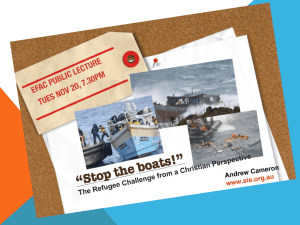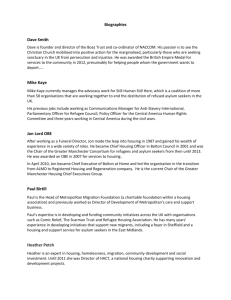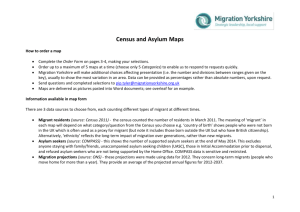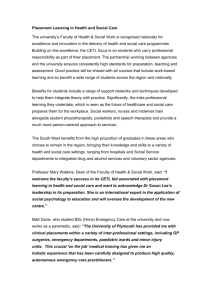Sample citations for Foster
advertisement
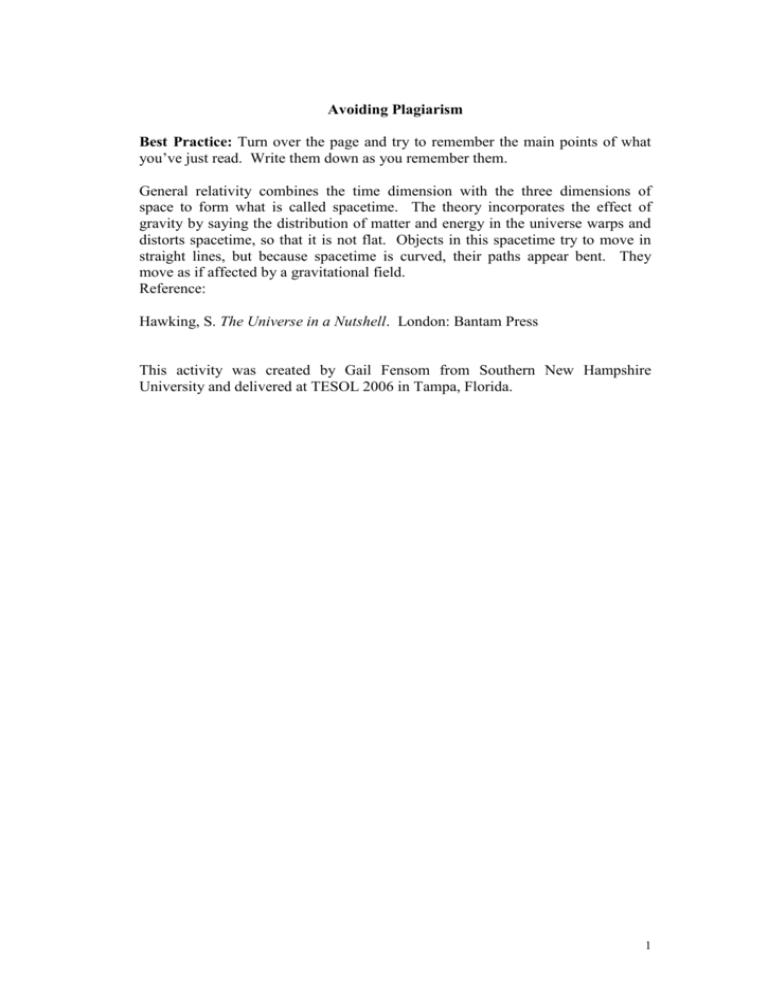
Avoiding Plagiarism Best Practice: Turn over the page and try to remember the main points of what you’ve just read. Write them down as you remember them. General relativity combines the time dimension with the three dimensions of space to form what is called spacetime. The theory incorporates the effect of gravity by saying the distribution of matter and energy in the universe warps and distorts spacetime, so that it is not flat. Objects in this spacetime try to move in straight lines, but because spacetime is curved, their paths appear bent. They move as if affected by a gravitational field. Reference: Hawking, S. The Universe in a Nutshell. London: Bantam Press This activity was created by Gail Fensom from Southern New Hampshire University and delivered at TESOL 2006 in Tampa, Florida. 1 2 Pedagogy for using sources – Reading for Stance Analysis and Summary of a Book Chapter from Understanding Global News Read the chapter. After you have completed reading, review the chapter up to the section titled “The approach of the book.” Identify the main claims put forward by the author. Identify each claim, the support used to justify that claim and any analysis or comment made by the author about the supporting evidence. When noting down the claims, support, analysis and comment, DO NOT copy the authors words or sentences directly from the text. Paraphrase or summarize the information and write it below. A complete example has been done for you. 1. Claim: People cannot escape from viewing the world through the perspective of their own life experiences. 1. Support: Example: The student map drawings provide evidence of personal/cultural bias. 2. Analysis and/or Comment: Identification and description of three central characteristics – centrality, volume and articulation – illustrate the perspective of the map drawer. The map drawers were predisposed to place their own country more centrally in the drawing, to accentuate its size and to provide clearer detail about its physical features. Identification of areas of commonality between map drawers shows a tendency to give more prominence to politically or economically powerful countries and/or to countries with which their own country has a close relationship. Fill in the missing section 2. Claim: Views of the world are mediated by culture. 2. Support: Historical Background: Description of the history of mapmaking, descriptions of modern maps and the identification of various calendar systems. 2. Analysis and/or Comment: The dominant geophysical and geopolitical descriptions of the world exemplify Western ethnocentrism. 3. Claim: The news is also a victim of ethnocentrism. 3. Support: Example: Deconstruction of a fictional typical news item from the Middle East. 3. Analysis and/or Comment: 3 This example introduces ideas or a means of questioning that will be used later in the chapter and in the book. 4. Claim: Notions of place or direction are often arbitrary and the fact that they are arbitrary makes it easier to imbue them with values that are culturally constructed. 4. Support: Examples: How notions of East and West are not fixed but shift around depending on who or what is being discussed. Examples of the connotations and collocations related to the words East and West in English. Same for North and South. Extension of the same idea to the terms First-, Second- and Third World. Extension to specific place names, e.g. names of countries, cities and landmarks. 4. Analysis and/or Comment: An important use of terms of location is to distinguish between groups of people. Naming practices and choice of name to refer to specific places reflects key historical and current viewpoints of power relationships in the world. 5. Claim: ‘Objective’ vocabulary for naming people is also highly subjective. 5. Support: 5. Analysis and/or Comment: 6. Claim: Journalists, teachers, scientists and others are not free to think and say whatever they want. Their use of language is subject to both social and psychological constraints. 6. Support: 6. Analysis and/or Comment: 7. Claim: Reality is complex and as a result we cannot think in terms of there being just one truth. In fact, there are many legitimate ways of viewing the world and it is important that we recognize this. 7. Support: 7. Analysis and/or Comment: 4 Pedagogy for using sources – To understand Route One • • • Build up to a text with numerous citations Reading the actual references This provides opportunities to demonstrate how other writers use sources, e.g. how they make connections between their own ideas and those of other writers. 5 Example 1 A Warm Welcome? Scottish and UK media reporting of an asylum-seeker murder. C. Coole. Lesson Focus: Summarizing with a purpose Mollard, C. (2001). Asylum: The truth behind the headlines, UK Poverty Programme of Oxfam GB. Oxford: Oxfam. This is a 19-page report on a study of the quality of press coverage on asylum in Scotland. It is an obvious source for Coole whose article reports on press coverage of a specific asylum-related incident in Scotland. How did Coole use this source? 1. 2. 3. 4. 5. 6. 7. 8. Where is this reference located in the article? What is the overall purpose of this section of the article? What comes before this reference? What comes after? Most of the summary is in Coole’s own words, but one section is a direct quote? Why do you think Coole chose to quote this particular section? List the reporting verbs Coole uses in her summary. Is there much variation in their meaning? Why do you think this is so? How does choice of reporting verb reflect the cited author’s voice? Mollard (2001) references in Coole’s article are on pp. 841-842 (This is Coole’s summary of Mollard.) Conclusions from Mollard’s (2001) analysis of Scottish media reporting on asylum seekers showed that the majority of press coverage was negative, or even hostile towards their presence in Scotland. The report states that many articles developed myths surrounding asylum seekers, based on false assumptions about their negative impact on Scottish society (Mollard, 2001: 9). Mollard (2001: 16) claims that the media would then justify and legitimize these viewpoints by printing readers’ letters expressing similar opinions on the issue. The key themes that underpinned the framing of the asylum story included: Only a tiny proportion of refugees are genuine, and the rest are ineligible for asylum. Asylum seekers get huge state handouts. Asylum seekers take jobs from local people. Asylum seekers are taking our housing leaving locals homeless. Some asylum seekers are more deserving of support than others. The report concluded: 6 . . . in the period covered by this report, much treatment of asylum issues in Scotland has been characterised by the use of myths and overtly negative language, the dehumanisation of asylum seekers, racial stereotyping, marginalization of asylum seekers and asylum supporters, and ill-informed journalism. Negative press coverage has been exacerbated by a lack of commitment by the UK government, the Scottish Executive, the Scottish Parliament, and local government to presenting positive information and challenging myths about asylum seekers. (Mollard, 2001: 26) Crucially, this negative press coverage helped shape public attitudes towards asylum seekers. It created a negative climate of opinion in Scotland towards asylum seekers before any had even arrived. This was something none of the newspapers would acknowledge when community tensions came to a head with the murder of Firsat Dag in Sighthill. Example 2 Racialized ‘othering’: The representation of asylum seekers in news media. O. Guedes Bailey and R. Harindranath Lesson Focus: How do these authors use external sources to build and support their argument? These are the authors’ research questions: How does journalistic practice contribute to a process of ‘othering’ of refugees and asylum seekers? What role do the labels such as ‘illegal’ and ‘bogus’ play in the politics of immigration control? What are the challenges confronting journalists reporting on asylum seekers in the context of globalization? Structuring a text and building an argument. 1. Look carefully at the organizational structure of the chapter. What are the different parts of the article and what purpose do they serve? Draw a text map. 2. In which section(s) of the chapter, do you find the most references to external sources? 3. What purpose do the authors’ have for citing an external source? Focus on the references to van Dijk (2000). First, identify the section the reference occurs in. Second, propose a purpose for the authors’ use of this reference. 7 Introduction Example of reporting of the Tampa incident in the Australian press. Paradox of porous borders for globalization of culture, but increased immigration control restricting the mobility of some groups of people. Background Defining the term ‘othering’. The study and discussion of the study. Conclusion. How news discourse frames asylum seekers. How the news media create an ‘us vs. them’ mentality. An analysis of the representation of asylum seekers and refugees in BBC and Channel Four news programs. Journalistic practice needs to reorient its discourse to better take account of the new relationship between the national and the global. 8 Van Dijk (2000) references 1. (p. 279) Defining a term. With regard to research on television news and asylum seekers, most studies demonstrate the persistence of stereotypes similar to those in the press (Hartmann and Husband 1974; Gordon and Rosenberg 1989: Van Dijk 1991, 2000). Stating a truism or general consensus in the field or topic area and supporting that with reference to the literature. 2. (p. 280) Reporting the study. This research [the author’s study reported in the preceding paragraph] suggests that news about refugees is often limited to few events: social problems (housing, employment. welfare); political opinions (politicians commenting on new policies or suggesting solutions); government policy (new laws restricting asylum seekers access); cultural difference (mostly in terms of deviance and criminality): public perception (in general based on misconceptions of welfare support for asylum seekers and refugees and incidents of violence. This list confirms the findings of Van Dijk's (2000) discursive analysis of British newspapers representation of asylum seekers. Overall, one could argue that the conclusions drawn by these studies suggests that there is an 'inferential racism'; at work in the news representation of asylum seekers which can be seen as a form of 'sanitized' racist discourse. Linking your study to the work of another scholar in the field. 3. (p. 282) Discussing the study. The `othering' at the beginning of the news story, along with the term `bogus', however, combine to racially criminalize a group of individuals, while `weaponry' and 'armoury' invoke associations with the guarding of national space from foreign invasion. This both confirms Saxton's (2003) argument, and supports findings by other studies on television representations of immigrants (Philo and Beanie 1999; Van Dijk 2000), which point out alarming similarities in the ways the media, in the last decade or so, have been `manufacturing' news on immigrants. Strengthening your findings by demonstrating that they build upon the arguments of others. 4. (p. 283) Conclusion. Studies such as Van Dijk (2000) and Saxton (2003) suggest that, despite the coverage of a range of events, both local and international, before and after the events of 11 September 2001, the portrayal of `asylum seekers' is remarkably consistent. Rather than be presented as people who are trying to escape threat, they are, in most cases, represented as the threat. It is a representation based on fear of 'them' as a threat to `our' national security and ways of life. The persistence of such divisive frames contributes to racialized `wedge' politics and to the justification of policies that approve or deny entry into countries on the basis of narrowly defined `national interests'. Introducing a point made by other scholars in order to use it to build your own point. 9 Route Two • • • • Identify one text that is widely cited Read the source text Follow it’s trail into other papers This is a “How to report” approach Example Activity - How to report on the research of others Key Articles Gass, S., Mackey, A., and Ross-Feldman, L. (2005). Task-Based Interactions in Classroom and Laboratory Settings, Language Learning, 55, 575-611 Foster, P. (1998). A classroom perspective on negotiation of meaning. Linguistics 19 (1) 1 –23. Applied Lesson Focus: How do other authors use Foster as an external source to build and support their arguments? Find your author’s research questions: 1. _____________________________________________ 2. _____________________________________________ 3. _____________________________________________ Structuring a text and building an argument. 4. Look carefully at the organizational structure of the article. What are the different parts of the article and what purpose do they serve? 5. In which section(s) of the chapter, do you find the most references to external sources? 6. What purpose do the authors’ have for citing an external source? Focus on the references to Foster (1998). First, identify the section the reference occurs in. Second, propose a purpose for the authors’ use of this reference. Third, identify the reporting verbs used. Consider this... What are the differences between the verbs used? What factors underlie the author’s choice of reporting verbs? 10 How do the choices indicate the writers’ understandings of Foster’s views? What would happen if you changed the reporting verbs used by the author? Sample citations for Foster To date, many of the empirical studies that support the interaction hypothesis have been carried out in laboratory settings, and some researchers have suggested that the same patterns may not occur in L2 classroom settings (Foster, 1998). In Foster’s words, her research call[s] into question the typicality of previous research into the incidence of negotiation of meaning and the justification therefore of constructing an SLA theory upon it. . . . teachers can be expected to show little interest in research that tells them negotiation of meaning flourishes under narrowly controlled conditions, especially conditions that would be very unusual in a classroom. (p. 19) Foster (1998) has questioned the extendibility of laboratory results on negotiation for meaning in L2 classrooms based on her research findings that negotiation did not occur in the classroom she studied. She goes on to say, on the basis of her classroom findings, that ‘‘learners appear to choose not to negotiate for meaning’’ (p. 20). In her study of negotiation for meaning in the ESL classroom, Foster (1998) found little evidence of negotiation in her data and interpreted her findings as suggesting that there is a difference between laboratory and classroom settings with regard to the amount of negotiation produced. Because of the small amount of negotiation in any of her tasks, she concluded that ‘‘uncoached negotiation for meaning’’ (p. 19) does not occur in the classroom. However, other interpretations of Foster’s data may be tenable. In her data, dyads carrying out information exchange tasks were the most successful in producing negotiation for meaning, with more of the negotiation incidences in her data occurring in a picture differences task than in a grammar task, suggesting that it may be worthwhile to investigate task types further.3 It is also possible that the data used in Foster’s analysis do not represent the full range of negotiation patterns that would exist in an entire class period. As in other studies of negotiation (Oliver, 1998, 2000, 2002), Foster examined only the first 10 min of data from her map task and the first 5 min of data from her remaining tasks. Although data-sampling practices like this are often necessary for comparability, it is possible that using only the first 5 min of the interaction in the majority of tasks may have obscured other patterns, since students might be ‘‘warming up’’ during the first few minutes of any activity (Aston, 1986, p. 132, cited in Shehadeh, 2001). It is thus possible that Foster’s results may not paint a complete picture of the classroom setting. Of course, classrooms are not as easily controlled as laboratories, and Foster (1998) makes an interesting point when she claims that if ‘‘language acquisition research wants to feed into teaching methodology, the research environment has to be willing to move out of the laboratory and into the classroom’’ (p. 21). Some researchers point to differences in settings to explain differential experimental results; for example, Foster (1998) notes that ‘‘the setting of the study within a classroom as opposed to a venue especially arranged for data collecting, is suggested as a significant variable’’ (p. 1). 11


